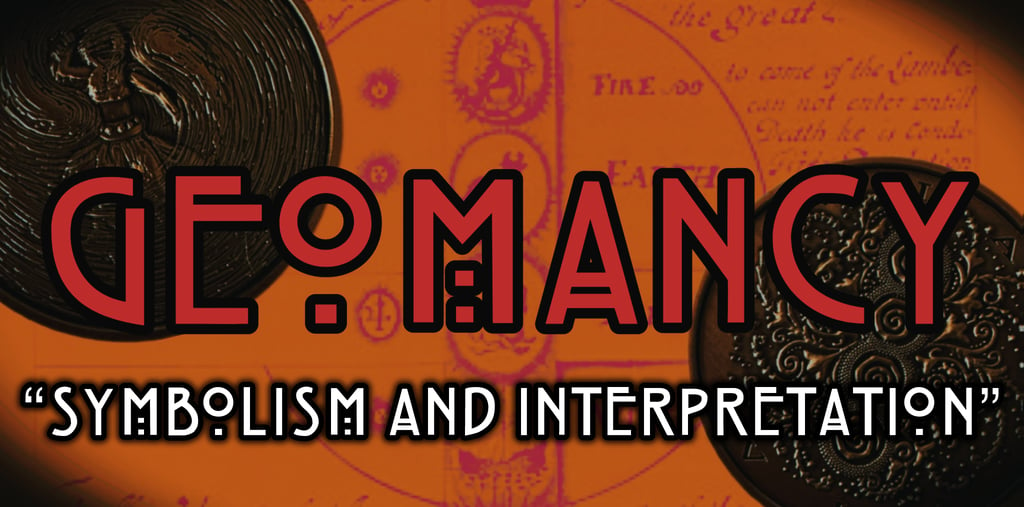Symbolism & Interpretation of Geomancy
Geomancy, an ancient divination practice, relies heavily on symbolism and interpretation to gain insight into the future and understand the underlying energies at play. The symbols and their meanings are key elements in the process of divination, guiding the geomancer in unraveling the messages hidden within the patterns. In this post, we will explore the symbolism and interpretation of geomancy.
Barry B.
8/27/20242 min read


Geomantic Figures
The geomantic figures themselves are the foundation of symbolism in geomancy. These figures are created by making a series of random marks and grouping them into sets of four. Each figure is composed of either one or two dots, representing the elements of fire, air, water, and earth.
Geomantic figures are symbolic representations used in divination, each embodying distinct qualities and characteristics. These figures can serve as mirrors reflecting the complexities of human experience, providing insights into a wide range of life aspects, such as personal relationships, career paths, emotional well-being, and spiritual growth. By interpreting these figures, individuals can gain a deeper understanding of their circumstances, uncover hidden patterns, and identify potential challenges or opportunities. The wisdom derived from these geomantic symbols encourages self-reflection and can guide decision-making, ultimately helping individuals navigate their journeys with greater clarity and purpose.
The interpretation of the figures also involves analyzing their relationships with each other. For instance, figures that share similar qualities or elements are considered harmonious, while conflicting elements may indicate challenges or obstacles.
Elemental Associations
In addition to the inherent qualities of the figures, geomancy also utilizes elemental associations to enhance the depth of interpretation. Each figure is associated with one of the four classical elements: fire, air, water, and earth.
The element of fire represents action, passion, and transformation. Air symbolizes intellect, communication, and adaptability. Water signifies emotions, intuition, and fluidity. Earth represents stability, practicality, and material concerns.
By considering the elemental associations of the figures, the geomancer can gain a deeper understanding of the energies and influences at play in a given situation.
Astrological Correspondences
Geomancy often incorporates astrological correspondences to further enrich its symbolic language. Each figure is associated with a specific astrological sign, planet, or element.
For example, the figure "Acquisitio" is associated with the astrological sign of Sagittarius and the planet Jupiter. This association suggests qualities such as expansion, optimism, and abundance.
The astrological correspondences provide additional layers of meaning and allow the geomancer to tap into the archetypal energies represented by the figures.
Context and Intuition
While the symbols and associations provide a framework for interpretation, the context in which the divination is done and the intuition of the geomancer are also essential elements.
The specific question or situation posed by the querent serves as the context for the divination. The geomancer must consider this context when interpreting the symbols to ensure that the reading is relevant and meaningful.
Additionally, the intuition of the geomancer plays a vital role in deciphering the messages hidden within the patterns. Intuition allows the geomancer to go beyond the surface-level interpretations and tap into deeper insights and meanings.
In summary, symbolism and interpretation are fundamental to geomancy. The geomantic figures, elemental associations, astrological correspondences, context, and intuition all come together to create a rich tapestry of meaning and insight. Through the careful analysis and interpretation of these symbols, the geomancer is able to provide guidance, understanding, and foresight into various aspects of life.
Social Media
Copyright © 2025 The Interactive Psychic. All rights reserved. The content, design, and images on this website are protected by international copyright laws. Unauthorized reproduction or distribution of any materials found on this site is strictly prohibited. The trademarks, logos, and service marks displayed on this website are the property of The Interactive Psychic and other respective owners. By accessing this website, you agree to abide by the copyright laws and respect the intellectual property rights of The Interactive Psychic . Any unauthorized use or reproduction of the materials may result in legal action. Thank you for your cooperation and understanding in upholding the rights and creativity of The Interactive Psychic .